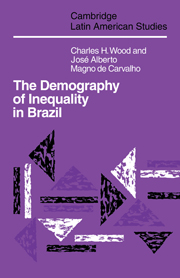Book contents
- Frontmatter
- Contents
- Illustrations
- List of tables
- Preface
- 1 Introduction
- 2 Framework for the study of population, development and inequality
- 3 Growth and distribution in historical perspective
- 4 Income inequality and length of life
- 5 Wage policy, infant mortality and collective social action in São Paulo
- 6 Racial inequality and child mortality
- 7 The “baby bust”
- 8 Income distribution and population growth
- 9 Agrarian structure and the rural exodus
- 10 Colonization and frontier expansion in Amazônia
- 11 Development and persistent underemployment
- 12 The demography of inequality in Brazil: summary and conclusion
- Appendix: A note on method
- Notes
- Bibliography
- Index
- CAMBRIDGE LATIN AMERICAN STUDIES
3 - Growth and distribution in historical perspective
Published online by Cambridge University Press: 04 August 2010
- Frontmatter
- Contents
- Illustrations
- List of tables
- Preface
- 1 Introduction
- 2 Framework for the study of population, development and inequality
- 3 Growth and distribution in historical perspective
- 4 Income inequality and length of life
- 5 Wage policy, infant mortality and collective social action in São Paulo
- 6 Racial inequality and child mortality
- 7 The “baby bust”
- 8 Income distribution and population growth
- 9 Agrarian structure and the rural exodus
- 10 Colonization and frontier expansion in Amazônia
- 11 Development and persistent underemployment
- 12 The demography of inequality in Brazil: summary and conclusion
- Appendix: A note on method
- Notes
- Bibliography
- Index
- CAMBRIDGE LATIN AMERICAN STUDIES
Summary
The first Portuguese to land in the New World in the sixteenth century settled the eastern seaboard of South America. The sparsely populated region they encountered stood in marked contrast to the densely inhabited Mexican meseta and Andean altiplano colonized by Spain. For the conquistadores in Spanish Latin America, the presence of long-established indigenous civilizations in Mexico and Peru meant the opportunity to appropriate vast quantities of gold and silver. The plunder of conquered territories provided Spain with a booty previously unknown to the world. As Spain consolidated the defense of its precious-metal-producing areas to the west, Portugal sought other ways to exploit its possessions in the Americas. The early colonists who settled the coastal regions turned to the export of brazilwood, a valuable dye product from which the country took its name. Within a few years of the initial expeditions, merchants obtained license from the crown to establish trading posts where logs were received from the local natives in exchange for tools and clothing. From these modest beginnings Brazil later grew into the largest and most economically powerful country in Latin America.
Economic cycles and the moving frontier
Sugar
The exploitation of hardwoods in the sixteenth century was only the first of many export cycles. By the mid-1500s the European population of the colony grew to about 100,000, and the once plentiful brazilwood forests were depleted (Simonsen 1969:121). Sugar then became Brazil's principal export product.
- Type
- Chapter
- Information
- The Demography of Inequality in Brazil , pp. 50 - 85Publisher: Cambridge University PressPrint publication year: 1988

